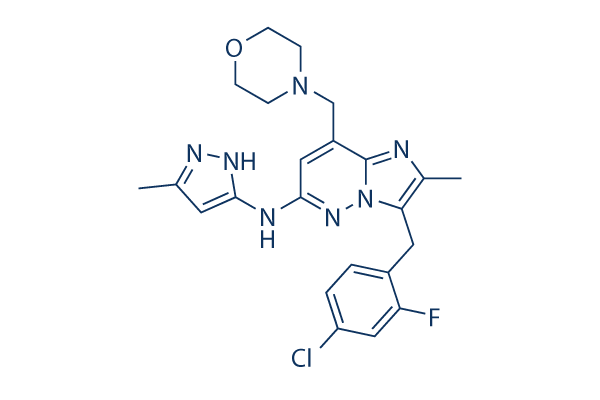| Description: |
Gandotinib (LY2784544) is a potent JAK2 inhibitor with IC50 of 3 nM. Gandotinib (LY2784544) also inhibits FLT3, FLT4, FGFR2, TYK2, and TRKB with IC50 of 4, 25, 32, 44, and 95 nM. |
| Target: |
JAK2:3 nM (IC50)
FGFR2:32 nM (IC50)
Flt-4:25 nM (IC50)
Tyk2:44 nM (IC50)
JAK3:48 nM (IC50)
FGFR3:106 nM (IC50)
KDR:109 nM (IC50)
FLT3:4 nM (IC50)
TRKB:95 nM (IC50)
ALK:138 nM (IC50)
MUSK:147 nM (IC50)
AURKA:168 nM (IC50)
MAP3K9:299 nM (IC50) |
| In Vivo: |
Gandotinib (LY2784544) effectively inhibits STAT5 phosphorylation in Ba/F3-JAK2V617F-GFP (green fluorescent protein) ascitic tumor cells (TED50=12.7 mg/kg) and significantly reduces (P<0.05) Ba/F3-JAK2V617F-GFP tumor burden in the JAK2V617F-induced MPN model (TED50=13.7 mg/kg, twice daily)[1]. |
| In Vitro: |
Gandotinib (LY2784544), a potent, selective and ATP-competitive inhibitor of janus kinase 2 (JAK2) tyrosine kinase. LY2784544 effectively inhibits JAK2V617F-driven signaling and cell proliferation in Ba/F3 cells (IC50=20 and 55 nM, respectively). In comparison, Gandotinib (LY2784544) is much less potent at inhibiting interleukin-3-stimulated wild-type JAK2-mediated signaling and cell proliferation (IC50=1183 and 1309 nM, respectively). Gandotinib (LY2784544) potently inhibits the JAK2V617F signaling (IC50=20 nM) but, remarkably, shows very minimal activity against the IL-3-activated wild-type JAK2 signaling with an IC50 of 1183 nM. LY2784544 inhibits the proliferation of JAK2V617F-expressing cells (IC50=55 nM) and is markedly less potent as an inhibitor of the proliferation of IL-3-stimulated wild-type JAK2 expressing Ba/F3 cells (IC50=1309 nM). Gandotinib (LY2784544) is potent in the cell-based TF-1 JAK2 assay (IC50=45 nM) and had the desired threshold selectivity in the NK-92 JAK3/JAK1 heterodimer assay (942 nM)[1]. |
| Cell Assay: |
Ba/F3 cells expressing JAK2V617F are placed in RPMI-1640-containing vehicle (DMSO) or Gandotinib (LY2784544) (concentration range, 0.001-20 μM) (1×104 cells/96-well). Ba/F3 cells expressing wild-type JAK2 are treated similarly except IL-3 (2 ng/mL) is added. After a 72-hour incubation, cell proliferation is assessed by adding Cell Titer 96 Aqueous One Solution Reagent (20 μL/well). The IC50 for inhibition of cell proliferation is calculated using the GraphPad Prism 4 software[1]. |
| Animal Administration: |
Mice[1] Dose- and time-dependent in vivo inhibition of JAK2V617F signaling is assessed by measuring inhibition of STAT5 phosphorylation in a mouse ascitic tumor model. Ba/F3-JAK2V617F-GFP cells (1×107) are implanted in the intraperitoneal cavity of severe combined immunodeficiency mice (SCID mice) and allowed to develop into ascitic tumors for 7 days. For dose-response studies (six animals/group), Gandotinib (LY2784544) is administered once by oral gavage (2.5, 5, 10, 20, 40, or 80 mg/kg), then 30 min later, ascitic tumor cells are collected, fixed, incubated for 2 h with Mouse-anti-pSTAT5 (pY694) Alexa Fluor 647 (1:10 dilution), and analyzed by flow cytometry. Time course studies are performed similarly, except the animals are treated with Gandotinib (LY2784544) at 20, 40 or 80 mg/kg and ascitic tumor cells collected at prespecified intervals of 0.25-6 h after dosing. Data are analyzed by the one-way analysis of variance, and Dunnett's test (α=0.05). Dose response data are analyzed with a four-parameter logistic curve-fitting program. |
| References: |
[1]. Ma L, et al. Discovery and characterization of LY2784544, a small-molecule tyrosine kinase inhibitor of JAK2V617F. Blood Cancer J. 2013, 3, e109. |






















